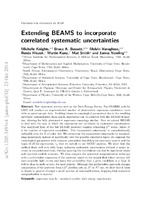| dc.contributor.author | Knights, Michelle | |
| dc.contributor.author | Bassett, Bruce A. | |
| dc.contributor.author | Varughese, Melvin | |
| dc.contributor.author | Hlozek, Renee | |
| dc.contributor.author | Kunz, Martin | |
| dc.contributor.author | Smith, Mat | |
| dc.contributor.author | Newling, James | |
| dc.date.accessioned | 2018-02-07T11:01:16Z | |
| dc.date.available | 2018-02-07T11:01:16Z | |
| dc.date.issued | 2013 | |
| dc.identifier.citation | Knights, M. et al. (2013). Extending BEAMS to incorporate correlated systematic uncertainties. Journal of Cosmology and Astroparticle Physics, 39 | en_US |
| dc.identifier.issn | 1475-7516 | |
| dc.identifier.uri | http://dx.doi.org/10.1088/1475-7516/2013/01/039 | |
| dc.identifier.uri | http://hdl.handle.net/10566/3488 | |
| dc.description.abstract | New supernova surveys such as the Dark Energy Survey, Pan-STARRS and the
LSST will produce an unprecedented number of photometric supernova candidates, most
with no spectroscopic data. Avoiding biases in cosmological parameters due to the resulting
inevitable contamination from non-Ia supernovae can be achieved with the BEAMS formalism,
allowing for fully photometric supernova cosmology studies. Here we extend BEAMS
to deal with the case in which the supernovae are correlated by systematic uncertainties.
The analytical form of the full BEAMS posterior requires evaluating 2N terms, where N
is the number of supernova candidates. This `exponential catastrophe' is computationally
unfeasible even for N of order 100. We circumvent the exponential catastrophe by marginalising
numerically instead of analytically over the possible supernova types: we augment the
cosmological parameters with nuisance parameters describing the covariance matrix and the
types of all the supernovae, i, that we include in our MCMC analysis. We show that this
method deals well even with large, unknown systematic uncertainties without a major increase
in computational time, whereas ignoring the correlations can lead to signi cant biases
and incorrect credible contours. We then compare the numerical marginalisation technique
with a perturbative expansion of the posterior based on the insight that future surveys will
have exquisite light curves and hence the probability that a given candidate is a Type Ia
will be close to unity or zero, for most objects. Although this perturbative approach changes
computation of the posterior from a 2N problem into an N2 or N3 one, we show that it leads
to biases in general through a small number of misclassiffcations, implying that numerical
marginalisation is superior. | en_US |
| dc.language.iso | en | en_US |
| dc.publisher | IOP Science | en_US |
| dc.rights | This is the pre-print version (From arXiv:1205.3493 ) of the article published online at: http://dx.doi.org/10.1088/1475-7516/2013/01/039 | |
| dc.subject | Supernova type Ia | en_US |
| dc.subject | Standard candles | en_US |
| dc.subject | Dark energy experiments | en_US |
| dc.title | Extending BEAMS to incorporate correlated systematic uncertainties | en_US |
| dc.type | Article | en_US |
| dc.privacy.showsubmitter | FALSE | |
| dc.status.ispeerreviewed | TRUE | |
| dc.description.accreditation | Web of Science | |

